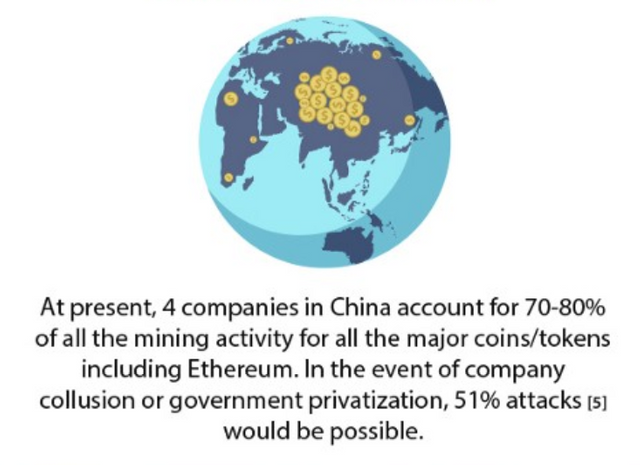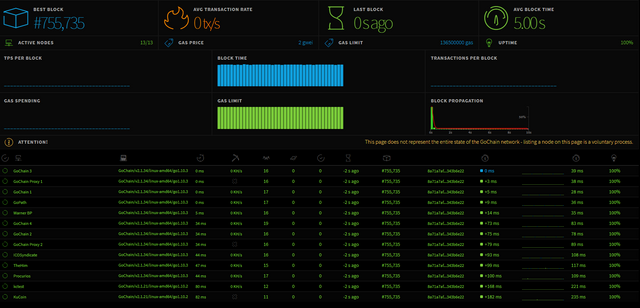The Solution to the Scalability trilemma! Introducing Gochain!
Ernest Cline's masterpiece "Ready Player one" carries along with it, a promise, a subtle, implicit tag that beckons "Climb aboard, this is a free ride to an adventure that explores the vast possibilities peculiar to the internet and the virtual world".
I find that the aforementioned description isn't too far off when referring to the blockchain technology. The blockchain innovation can be likened to a virtual universe with multi-sectors, associated communities coupled with a specified system of governance. Not only is the blockchain technology innovative, it is futuristic too. The blockchain cuts across, (to mention a few) finance, transportation and the entertainment industries as well as the political and economic sectors.
The blockchain continues to build upon the 20th century invention, (the internet) by being the foundation for very many sub-universes and hosting platforms developed to solve endless real world problems. The bitcoin and ethereum network although avant-garde, (each being an entire blockchain and representing the status-quo) currently subsist on anti-utopian peculiarities.
The negative feedback loop created as a result of these "untrusted, unpermissioned networks" has led to the failure of centralization, slothful speeds, decreased throughput, as well as the inability of these networks to perform real world transactions in real time.
Take the 2017 cryptokitties problem, for example. Which served to magnify the preexisting weaknesses of the ethereum network. In November 2017, The ethereum network became inundated, with the Cryptokitty Dapp "accounting for nearly 15% of Ethereum’s total network transactions". The resultant effects, bearing in mind that the ethereum network is not suited for such massive transaction volume, (as a result of its inefficient consensus algorithm and several other factors)
were drastically reduced speeds and slower transaction times.
While real world transactions in centralized platforms like Visa
"average up to about 150 million transactions per day, with the ability to process as much as 56,000 transactions per seconds, the ethereum and bitcoin network fall short of these realistic world processing values at processing rates of 13 tps and 5tps respectively".
Smart contracts, softwares with inbuilt conditions, automatically executed and deployed on the ethereum blockchain are mainly immutable/unalterable. However, these contracts usually contain bugs that are mostly inconspicuous at the time of release.
Unlike real world upgradeable, alterable contracts which can be reviewed based on already specified contract terms, ethereum based smart contracts lack such flexibility. This has led to very many instances of fraud and malicious hack as a result of oversight. Stark examples include the DAO $50 million hack.
While Ernest Cline's book depicts a dystopia, communities in the blockchain continue to strive to improve upon the status-quo.
According to the ethereum cofounder, Vitalik Buterin, the three major bottlenecks plaguing the network and preventing its absolute optimization are the problems of "Scalability, Decentralization and Security". They are referred to as the scalability trilemma and have to be solved simultaneously in order for the ethereum blockchain to scale.
Exploring The Scalability Trilemma, Introducing the GoChain Solution!
.png)
GoC
The Bitcoin network operates with the proof of work consensus algorithm, an unsustainable, unpermissioned mode of operation that requires massive competitive computational power in order to solve block problems and mine new blocks. While this consensus model has the internal mechanism of been Cost prohibitive, It consumes a gargantuan amount of energy, has a low performance and fails to deliver the core essence of the blockchain "centralization".
"75% of blocks are mined by large Chinese mining companies. This is true of Bitcoin, Bitcoin Cash, Ethereum and top cryptocurrencies. In the event of company collusion or government privatization, 51% attacks would be possible".
.png)
GOC
With the POW, Miners are more likely to aggregate in regions with cheaper electricity thus enabling centralization. What's more? Statistics show that the ethereum network uses the equivalent power of 1 million households" with bitcoin transactions predicted to "consume as much electricity as Denmark by 2020".
The proof of Stake consensus algorithm, an update that comes along with the ethereum Casper implementation barely shows promise.
While it subverts the massive computational power required for mining, the proof of stake consensus algorithm does not prevent bad actors or malicious attacks. POS consensus algorithm makes assumptions about the interests of the randomly chosen validators by way of their measured stake in the network.
Also, while the POS, may be energy conserving, it is not built for high performance, initial target for the ethereum Casper implementation been 100tps.
The Gochain proof of Reputation.
The proof of reputation consensus algorithm adopted by the Gochain network efficiently combines advantageous portions of the POW and POS. This consensus mechanism relies on the reputation of select nodes or authorized signers in order to keep the network secure.
Proof of Stake vs Proof of Work vs Proof Authority.
The importance of the public perception of a business aka reputation cannot be overemphasized. This Article indicates the high costs of controversy on a companies reputation and the resulting negative domino effect that stems from it. The POR consensus model makes use of Companies, businesses, verifiable entities that the network can hold to account.
"Individual's are more likely to trust people that they can hold to account. Businesses that act in unethical ways suffer on many levels including fines, loss of revenue, decrease in valuation, branding, and public relations.
Board members, directors, officers all share the blame and lose their good reputation if they act in bad faith or negligently/knowingly expose the company to risk".
Unlike the Proof of stake consensus model where nothing disincentivizes selected validators from been bad actors, these businesses have quite a lot to lose if caught cheating.
As soon as a company proves reputation, they may be voted into the network as an authoritative node and much like in the Proof of authority consensus, only authoritative nodes can sign and validate blocks.
Verification Processes.
Companies are verified in two separate ways. First is by providing their Dun & Bradstreet D- U-N-S number an identifier that allows voters access to the companies official contact information.
The final secondary verification involves the validation of DNS records, a form of verifying domain ownership. Gochain will host a decentralized application for the sole purpose of creating tokens and validating DNS records.
In the Gochain network, reputation is judged based on:-
A company's market cap.
The Gochain network favors bigger market caps to smaller ones.If a company is publicly or privately held with preference for public trading companies since they experience more direct and immediate losses and
Brand significance, with preference for companies that require strong public brands.
Since these select businesses function as authorized signers, I.e trusted nodes that create blocks, sign them, and distribute them to other nodes, mining costs are eliminated. Blocks are signed and new ones are created without the associated mining costs, thereby solving the excessive energy consumption, poor performance, and lack of decentralization problems peculiar to the Proof of Work model.
Tackling the bottlenecks, the Gochain Approach.
Decentralization.
The Gochain consensus algorithm employs the use of 50 nodes distributed in different geographical locations. The nodes will be chosen in different countries. This serves to ensure that no single power dominates the network. This form of decentralized distribution also eliminates the possibility of a government interference or takeover, and reduces greatly the possibility of a 51% attack.
Given N authorized signers, a signer may only sign a block every (N/2) + 1. This ensures that a bad actor would need to control more than 50% of signers to perform a malicious attack".
Authorized signers are also incentivized through GoChain Coins (GOC) per block signed though the specific rate will reduce over time. A small transaction fee is also made available for the node's keep for each signed block.
Upgradeability of Smart Contracts.
The Gochain goal is to create real world, flexible, alterable, terminable and pausable contracts able to be adjusted based on clearly defined contract terms just like in the real world. This idea would go a long way and will serve as a good deterrent for possible "hard or soft forks" in the nearest future.
While the Gochain network will continue to deploy default immutable smart contract types for compatibility with the ethereum network, the white listing security feature would be made available for smart contracts as a means of protection in order to minimize attack risks.
Storage.
While Ethereum’s energy consumption has been estimated to be at 14 TWh and rising.
Assuming 450W power usage per server [31] the Gochain blockchain 50-node cluster will only use 197.1 MWh about 0.001% of the energy of the Ethereum network".
The Gochain network involves the combination of efficient multi-solutions in order to solve the storage challenge plaguing the Ethereum network. By reducing the data size of each block as well as the state tree, exploring different storage schemes and then utilizing Offchain storage,
"Go Current cloud at a pricing of $0.022 USD per GB/month makes storing a copy of the blockchain history only $1,161.60 USD per year of block data".
Scalability.
With its mainnet up and running on an average of 1,300 transactions per second, the Gochain network is able to provide:-
Transaction Fees At Least 7500x Less Than Ethereum.
10x more decentralization!
100x increase in speed
1000x improvement in energy consumption.
These are not hyper exaggerated numbers. This is made achievable by the proof of reputation consensus model. The advent of a trusted, permissioned network allows for a positive feedback processes within the Gochain network.
As seen in the Gochain whitepaper,
"Systems that handle high volumes, like Google searches or Visa payments can handle high load only because they trust the servers and the network they are running on.By using trusted nodes, transactions can be verified very quickly and the volume of transactions the network can handle increases by orders of magnitude"
The gas limit and block times are also rendered adjustable. Since the Proof of reputation functions with a relatively smaller set of signers compared to the amount of miners in POW, the Gochain network allows for the possibility of increased block sizes which in turn greatly reduces block times. This tweak allows for a great increase in the number of tps.
Use-cases.
Developer.
One particularly kudos-worthy feature of the Gochain platform is the option of seamless transitioning it offers preexisting ethereum Dapps. Without modifying code, developers are able to integrate preexisting decentralized applications into the scalable, decentralized and secure Gochain network.
Smart contract white listing feature.
The Gochain end goal for these deployed contracts is to make them as real world like as possible. Not only is the network aiming to make smart contracts flexible and upgradeable, the Gochain network has developed the white listing function in order to make these contracts more secure and attack proof.
User.
Users get to optimize the blockchain. Dapps run in real time with none of the archetypal ethereum network slothfulness and users experience greatly reduced transaction fees. (As a result of lower market cap compared to ethereum and the 1 billion outstanding Gotokens vs Ethereum’s 100 million tokens)
Conclusion.
Every stakeholder gets to maximize the potentials of the blockchain innovation through the Gochain network.
Mainnet launched, Usability of Gotokens, Listed exchanges, Selected nodes.
.png)
Mainnet
The Gochain tokens power network transactions and decentralized applications.
Listed exchanges:- Kucoin
Selected nodes, Check here
Exploring different possible scenarios of the ethereum network processing large transaction volumes E.g 1000 Dapps processing a transaction at 1tps, brings to mind an image of drudgery so visceral that It is almost dystopian. What's more unfortunate? As more industries continue to adopt the blockchain innovation and more decentralized applications are built, it is bound to worsen.
Gochain is here ready for the rescue! Tighten your seatbelt! Climb aboard this utopian train. We no longer have to settle for the stereotypical perspective of things, because the Gochain network is here to transform the worldview of the blockchain technology.
https://steemit.com/crypto/@originalworks/640-steem-sponsored-writing-contest-gochain
gochain2018
upvote for me please? https://steemit.com/news/@bible.com/2sysip
@contestbot
This post has been submitted for the @OriginalWorks Sponsored Writing Contest!
You can also follow @contestbot to be notified of future contests!
Ru
Приветствую. Представляю студию блокчейн-копирайтинга. Предлагаю наши услуги по написанию WhitePaper, созданию видеороликов , написанию уникальных статей и обзоров (в том числе для steemit), переводов. Огромный опыт и большой штат сотрудников. Списко наших услуг и портфолио в нашем телеграм канале или на сайте.
En
Hello everyone! I present to you our blockchain copywriting studio. We propose to you next services: writing WhitePaper, creating videos, , translations, writing unique articles and reviews (Including for steemit). Extensive experience and highly qualified team. List of services and portforlio in our telegram channel or on our website.